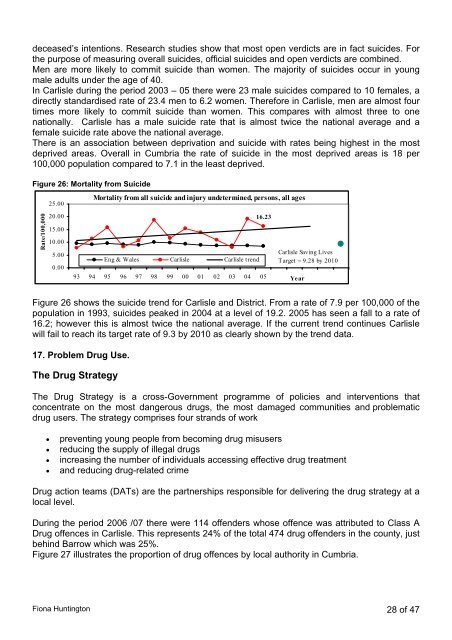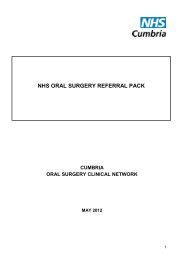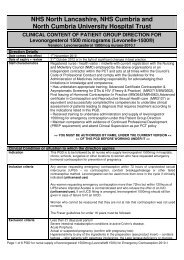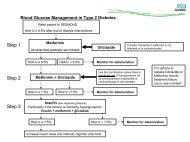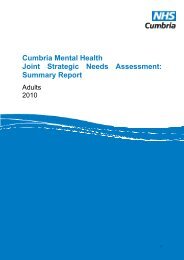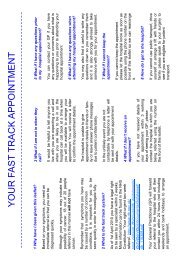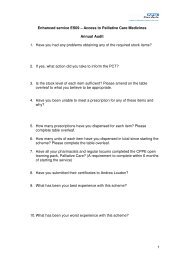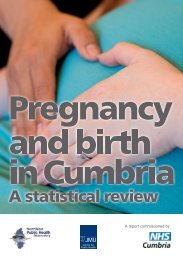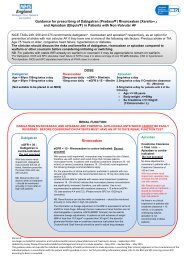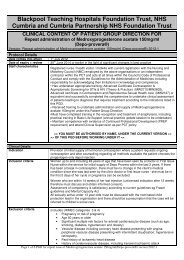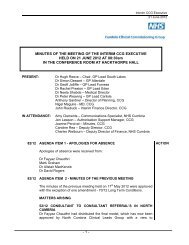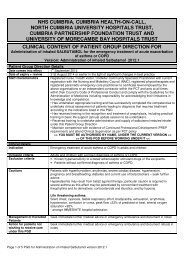Carlisle is the most northerly city in England, and the ... - NHS Cumbria
Carlisle is the most northerly city in England, and the ... - NHS Cumbria
Carlisle is the most northerly city in England, and the ... - NHS Cumbria
- No tags were found...
Create successful ePaper yourself
Turn your PDF publications into a flip-book with our unique Google optimized e-Paper software.
deceased’s <strong>in</strong>tentions. Research studies show that <strong>most</strong> open verdicts are <strong>in</strong> fact suicides. For<strong>the</strong> purpose of measur<strong>in</strong>g overall suicides, official suicides <strong>and</strong> open verdicts are comb<strong>in</strong>ed.Men are more likely to commit suicide than women. The majority of suicides occur <strong>in</strong> youngmale adults under <strong>the</strong> age of 40.In <strong>Carl<strong>is</strong>le</strong> dur<strong>in</strong>g <strong>the</strong> period 2003 – 05 <strong>the</strong>re were 23 male suicides compared to 10 females, adirectly st<strong>and</strong>ard<strong>is</strong>ed rate of 23.4 men to 6.2 women. Therefore <strong>in</strong> <strong>Carl<strong>is</strong>le</strong>, men are al<strong>most</strong> fourtimes more likely to commit suicide than women. Th<strong>is</strong> compares with al<strong>most</strong> three to onenationally. <strong>Carl<strong>is</strong>le</strong> has a male suicide rate that <strong>is</strong> al<strong>most</strong> twice <strong>the</strong> national average <strong>and</strong> afemale suicide rate above <strong>the</strong> national average.There <strong>is</strong> an association between deprivation <strong>and</strong> suicide with rates be<strong>in</strong>g highest <strong>in</strong> <strong>the</strong> <strong>most</strong>deprived areas. Overall <strong>in</strong> <strong>Cumbria</strong> <strong>the</strong> rate of suicide <strong>in</strong> <strong>the</strong> <strong>most</strong> deprived areas <strong>is</strong> 18 per100,000 population compared to 7.1 <strong>in</strong> <strong>the</strong> least deprived.Figure 26: Mortality from Suicide25.00Mortality from all suicide <strong>and</strong> <strong>in</strong>jury undeterm<strong>in</strong>ed, persons, all agesRate/100,00020.0015.0010.005.000.00Eng & Wales <strong>Carl<strong>is</strong>le</strong> <strong>Carl<strong>is</strong>le</strong> trend16.2393 94 95 96 97 98 99 00 01 02 03 04 05 Year<strong>Carl<strong>is</strong>le</strong> Sav<strong>in</strong>g LivesTarget = 9.28 by 2010Figure 26 shows <strong>the</strong> suicide trend for <strong>Carl<strong>is</strong>le</strong> <strong>and</strong> D<strong>is</strong>trict. From a rate of 7.9 per 100,000 of <strong>the</strong>population <strong>in</strong> 1993, suicides peaked <strong>in</strong> 2004 at a level of 19.2. 2005 has seen a fall to a rate of16.2; however th<strong>is</strong> <strong>is</strong> al<strong>most</strong> twice <strong>the</strong> national average. If <strong>the</strong> current trend cont<strong>in</strong>ues <strong>Carl<strong>is</strong>le</strong>will fail to reach its target rate of 9.3 by 2010 as clearly shown by <strong>the</strong> trend data.17. Problem Drug Use.The Drug StrategyThe Drug Strategy <strong>is</strong> a cross-Government programme of policies <strong>and</strong> <strong>in</strong>terventions thatconcentrate on <strong>the</strong> <strong>most</strong> dangerous drugs, <strong>the</strong> <strong>most</strong> damaged communities <strong>and</strong> problematicdrug users. The strategy compr<strong>is</strong>es four str<strong>and</strong>s of work• prevent<strong>in</strong>g young people from becom<strong>in</strong>g drug m<strong>is</strong>users• reduc<strong>in</strong>g <strong>the</strong> supply of illegal drugs• <strong>in</strong>creas<strong>in</strong>g <strong>the</strong> number of <strong>in</strong>dividuals access<strong>in</strong>g effective drug treatment• <strong>and</strong> reduc<strong>in</strong>g drug-related crimeDrug action teams (DATs) are <strong>the</strong> partnerships responsible for deliver<strong>in</strong>g <strong>the</strong> drug strategy at alocal level.Dur<strong>in</strong>g <strong>the</strong> period 2006 /07 <strong>the</strong>re were 114 offenders whose offence was attributed to Class ADrug offences <strong>in</strong> <strong>Carl<strong>is</strong>le</strong>. Th<strong>is</strong> represents 24% of <strong>the</strong> total 474 drug offenders <strong>in</strong> <strong>the</strong> county, justbeh<strong>in</strong>d Barrow which was 25%.Figure 27 illustrates <strong>the</strong> proportion of drug offences by local authority <strong>in</strong> <strong>Cumbria</strong>.Fiona Hunt<strong>in</strong>gton 28 of 47


